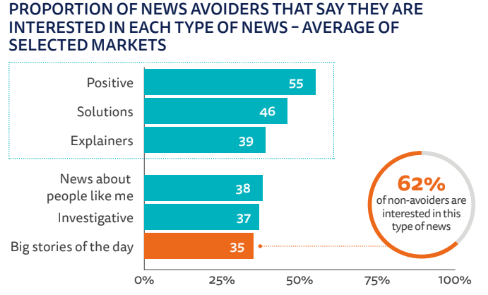[This is a sponsored post from ONA supporter Reuters. Reuters, the news and media division of Thomson Reuters, is the largest global, real-time news and information provider. They offer flexible products and services that give you the freedom to experiment with the way you work – meaning you can quickly meet the changing demands of your audience, whilst building continued business success.]
The Reuters Institute at Oxford University has launched the annual Digital News Report 2023 (DNR), full of fascinating insights into how the world of news is changing.
The findings of the report all point to the fact that changing consumption habits and preferences mean news publishers need to keep transforming. The need for change in both how the news is covered and how it is delivered has become more pronounced.
Download a copy of the report.
The global news industry has been grappling with the shift to digital over the last years. The pace of that change is only speeding up as audience behaviours and attitudes change, and the battle for both relevance and revenue grows.
Audiences are more social than ever
The DNR has been tracking where people find news for the last decade. The global trend is clear: Nearly a third of people get their news mostly from social media and another quarter from search. This is despite policy changes at Meta and Twitter which have hit both traffic and revenue over the last year.

For the younger generation and markets in Asia, Latin America and Africa and the difference is even more stark. Among 18-24 year-olds, 43% say social media is now their main source of news.
But social media is not one-size-fits-all. The study shows a huge jump in the use of TikTok and other video platforms where people tend to follow people, not brands. On the younger social platforms, there is a healthy spread of the type of news people want. The challenge will be how to re-version stories – and tell different stories – for different audiences in different places.
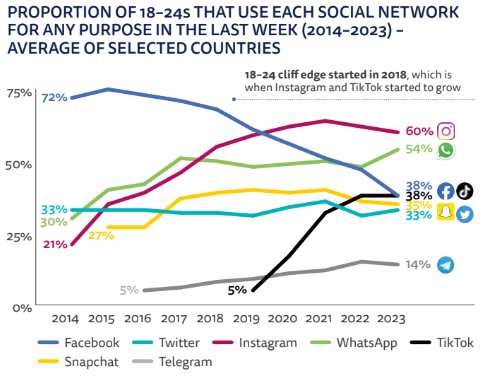 There is also a growing difference in how younger audiences prefer getting the news. While reading is still the most preferred mode, video and audio are much more popular with the younger generations.
There is also a growing difference in how younger audiences prefer getting the news. While reading is still the most preferred mode, video and audio are much more popular with the younger generations.
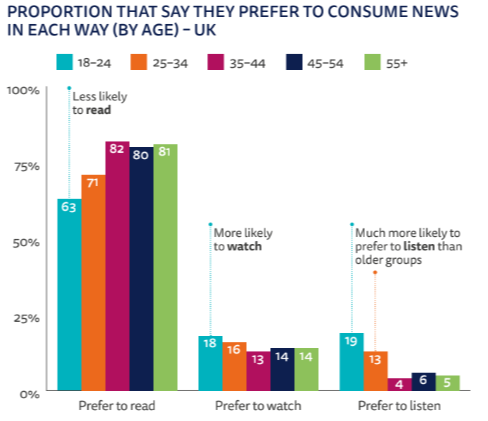 People are worried about misinformation
People are worried about misinformation
Given how much people depend on social media for news, it is inevitable that they also worry about whether what they see is real or fake. This is ever more the case in a world where high-quality, AI-generated content is available.
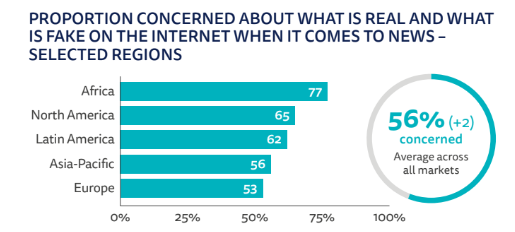 Reuters has been investing in verification; both with the UGC team seeking to check and clear content from social media and the fact-checking team debunking content that is untrue.
Reuters has been investing in verification; both with the UGC team seeking to check and clear content from social media and the fact-checking team debunking content that is untrue.
Reuters also has an advantage in combating misinformation, with expert reporting teams around the world who can point out misinformation campaigns. This helps verify social media content and, crucially, provide trustworthy, fact-based reporting on the ground.
Publishers need to provide value to get subscriptions
The proportion of people paying for news worldwide is still low at 17%, the same level as last year. That raises the question of whether we have reached the peak of the subscription trend.
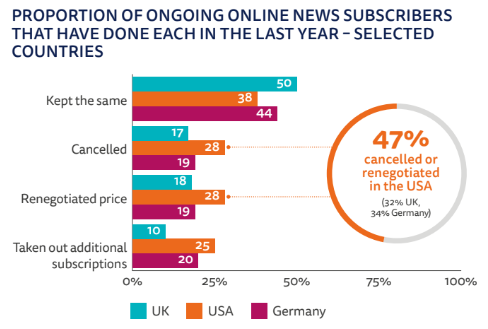 When asked what would entice them to pay for news, people in the survey pointed to the need for journalism to be cheaper or more valuable to them in terms of content or product experience.
When asked what would entice them to pay for news, people in the survey pointed to the need for journalism to be cheaper or more valuable to them in terms of content or product experience.
This trend will continue to play out around the world, so, it’s important to be close to your customers and be creative about how you can help them as they try to find new audiences and new revenue streams.
Some people are disengaging from news entirely
The report also delves into the growing theme of “news avoidance”, or people turning away from the news, often because it is too depressing. It is worth remembering that we saw news engagement numbers hit highs during 2020 at the height of the COVID-19 pandemic. Why? Because news was useful and necessary at a time of personal peril.
